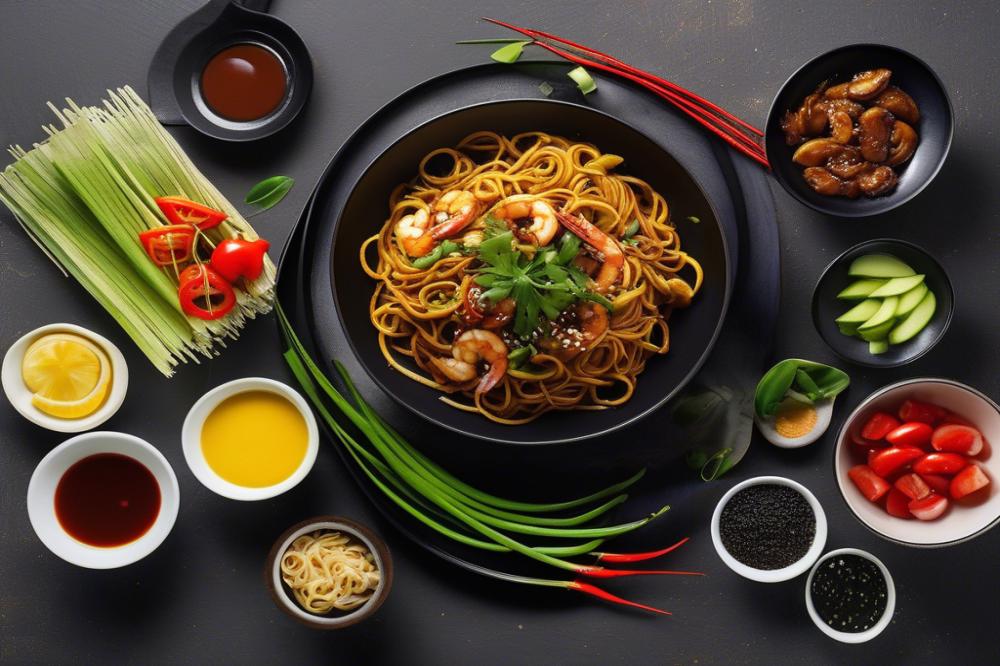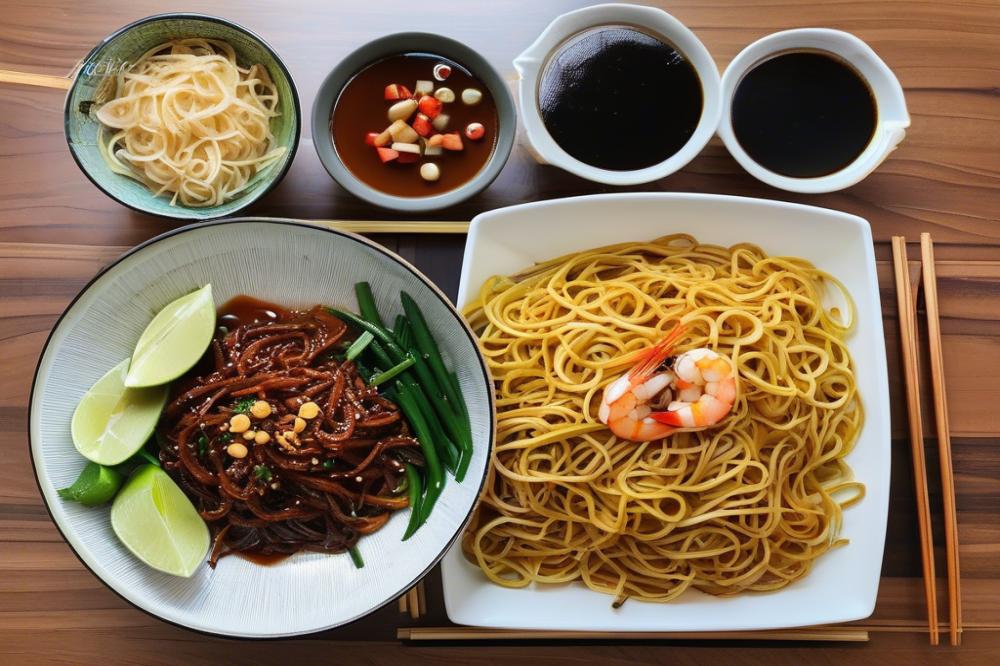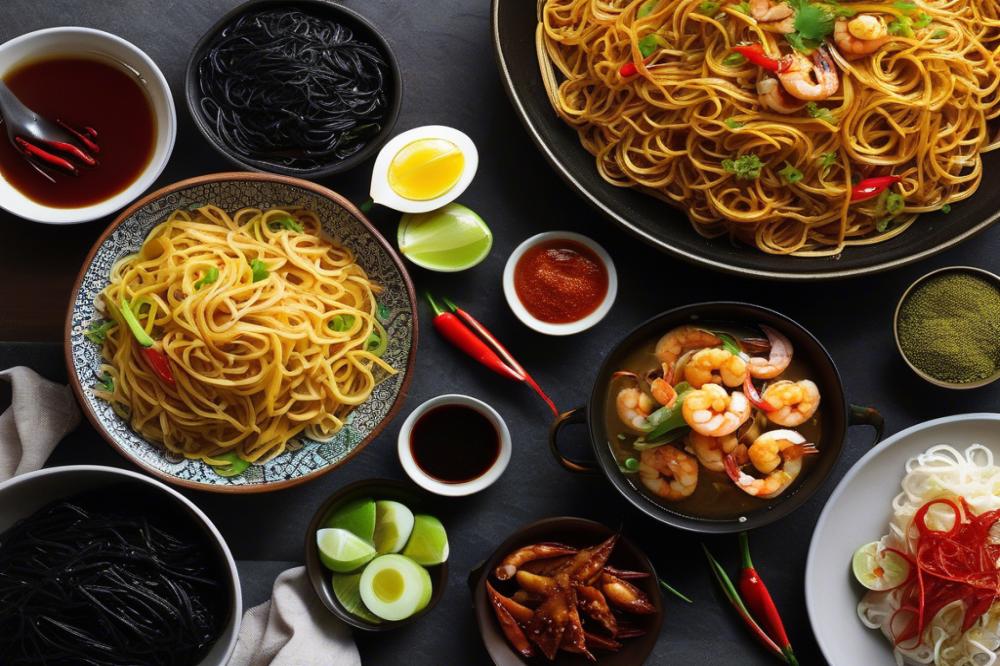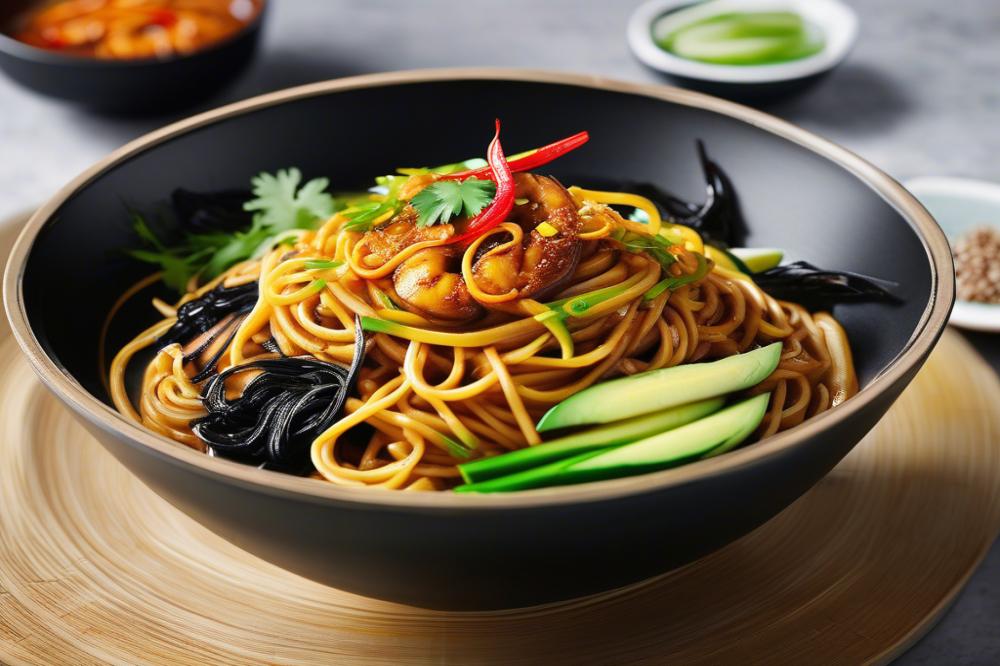Introduction
Hokkien Mee is a beloved dish that holds a special place in Malaysian cuisine. This stir-fried noodles dish is known for its savory flavors and rich textures. It combines ingredients like shrimp, pork, and garlic, all tossed together with black sauce. The result is a mouthwatering blend that delights the senses.
Black sauce plays a pivotal role in creating the distinct flavor profile. This sauce adds a deep, sweet, and slightly salty taste that enhances the other components of the dish. Soy sauce, along with a medley of Chinese herbs, contributes to the complexity of flavors. Each bite brings a burst of umami that is hard to forget.
Popular as street food, this dish can be found in bustling markets and food stalls. Many people enjoy grabbing a quick meal of Malaysian noodles on their lunch breaks or after a night out. With its easy recipe, anyone can try making this authentic dish at home.
The Authentic Hokkien Mee Recipe

Ingredients List with Quantities
- 300g yellow noodles
- 200g shrimp, peeled and deveined
- 200g pork, thinly sliced
- 4 cloves garlic, minced
- 2 tbsp black soy sauce
- 1 tbsp light soy sauce
- 1 tsp oyster sauce
- 1 tbsp vegetable oil
- 1/2 cup water
- 1 stalk green onion, sliced
- Salt and pepper to taste
Cooking Instructions
Start by heating the vegetable oil in a wok over medium-high heat. Add minced garlic and stir-fry it until fragrant. This is where the savory aroma begins. Next, introduce the thinly sliced pork and cook it until it turns a nice brown color. The pork adds depth to the flavors.
After the pork, toss in the shrimp. Cook them until they become pink and opaque. This usually takes a few minutes. Once the shrimp are done, stir in the yellow noodles along with the black soy sauce, light soy sauce, and oyster sauce. These sauces are key to achieving that rich, umami taste.
Now, pour in the half-cup of water to help the noodles cook evenly and absorb all those delicious flavors. Stir-fry the mixture thoroughly until everything is well combined. Season with salt and pepper to taste, then fold in the sliced green onion for a fresh hint.
Finally, serve your stir-fried noodles hot. This dish is a delightful example of Malaysian street food. Enjoy the unique combination of shrimp and pork enhanced by the black sauce and garlic.
Nutritional Information for Key Ingredients
- Yellow noodles: They provide carbohydrates and a touch of protein.
- Shrimp: This ingredient is high in protein while remaining low in fat.
- Pork: A great protein source, it contains essential vitamins like B6 and B12.
- Garlic: Known for its antibacterial properties, it is rich in antioxidants.
- Soy sauce: Contains sodium, contributing an umami flavor to the dish.
- Black soy sauce: This adds depth of taste and contributes some beneficial minerals.
Variations of Hokkien Mee

Across Malaysia, regional variations of stir-fried noodles highlight local flavors and ingredients. In Penang, for instance, the dish is often lighter and features a different type of black sauce, resulting in a flavor profile all its own. Meanwhile, the Kuala Lumpur version tends to be heartier, featuring richer soy sauce and generous servings of pork and shrimp.
Outside Malaysia, neighboring countries have their interpretations as well. In Indonesia, a similar noodle dish can be found, influenced by local spices and herbs. This variant often includes a unique blend of chili, adding an extra kick to the dish. Singapore also offers its take on the classic, sometimes swapping out traditional ingredients for seafood, or adding a touch of curry powder for a different twist.
Many people enjoy personalizing their recipes. Some have embraced alternative ingredients, allowing for various protein choices. Using chicken instead of pork can create a lighter texture without trading off on the rich, savory flavors. For vegetarians, the dish can easily be modified to include an array of fresh vegetables instead. Tofu paired with vibrant greens provides a tasty option that still stays true to the essence of the dish.
Garnishes and preparation methods can also vary greatly. Adding more garlic or incorporating Chinese herbs can shift the flavors in exciting ways. Street food stalls often serve Hokkien Mee with unique spice blends, which can elevate the experience of eating this dish. For an even bolder taste, some enthusiasts recommend tossing in additional sauces, like oyster sauce or chili paste, during cooking, creating a rich layer of flavor.
Many find that experimenting with different cooking techniques brings out new shades of taste. Some opt to fry the noodles until crispy, while others prefer a softer texture. This choice impacts the overall enjoyment of each bite. Whether one prefers the traditional approach or to try a new twist, Hokkien Mee remains an easy recipe that continues to inspire food lovers.
The Cultural Importance of Hokkien Mee

Historical roots connect Hokkien Mee to the Malaysian Chinese communities. It traces its origins back to Fujian province in China. Over the years, this dish made its way to Malaysia. Here, it evolved, adopting local flavors and ingredients.
Family gatherings often feature this dish prominently. Parents pass down recipes to their children. Special occasions, like birthdays and festivals, are incomplete without stir-fried noodles. Friends also enjoy sharing a meal together, creating bonds over delicious plates of shrimp and pork.
Street food culture thrives in Malaysia, and Hokkien Mee is a star attraction. Vendors cook it right before your eyes, filling the air with the aromas of garlic and black sauce. It draws crowds, and people eagerly line up for a taste. This easy recipe combines freshness with rich flavors, capturing the hearts of many.
Preserving culinary traditions is vital within communities. As recipes are shared, they connect generations. Each cook adds their own touch, but the essence remains authentic. With the use of soy sauce and Chinese herbs, the dish reflects a rich history. Hokkien Mee serves as a flavorful reminder of heritage and identity.
Tips for Making the Perfect Hokkien Mee
Best Practices for Cooking Noodles
Begin by using fresh stir-fried noodles. Freshness makes a noticeable difference in texture and taste. If you cannot find fresh noodles, dried ones will do, but they need proper cooking. Boil them until just tender, then drain and rinse under cold water. This process helps prevent stickiness. When frying, ensure the wok is hot. A high temperature creates that desirable charred flavor. Work quickly to avoid overcooking the noodles, as they should remain firm yet chewy.
Choosing the Right Type of Soy Sauce
Selecting the right soy sauce is crucial. Dark soy sauce is preferred for Hokkien Mee due to its rich color and sweetness. It gives the dish its signature black sauce appearance. A good quality light soy sauce can enhance the overall flavor. Mixing both types in your recipe provides a better taste profile. Brands vary, so try different ones until you find your favorite. Using a combination of sauces allows for a more authentic experience, closely resembling street food versions.
Recommended Side Dishes and Pairings
Pairing your meal with the right side dishes elevates the experience. Consider serving it with simple pickled vegetables. Their tangy flavor balances the rich soy sauce. Other options include fresh cucumber slices or fried tofu. These add contrasting textures and tastes. For protein, grilled shrimp or sliced pork cooked with garlic works wonderfully. Both complement the dish without overpowering it. When enjoying Hokkien Mee, a cold beverage like lime juice can refresh your palate. This combination creates a fun and engaging dining experience.
Final Thoughts on this Beloved Dish
The delightful combination of flavors in this dish makes it a standout among Malaysian favorites. Rich black sauce adds depth, while tender stir-fried noodles create a satisfying texture. Diners treasure this meal not just for its taste but also for the stories it carries. Recipes have been passed down through generations, showcasing a commitment to authenticity and tradition.
If you’re intrigued, trying this recipe at home is a fantastic way to experience the culture firsthand. Gathering fresh ingredients and following the steps can be quite rewarding. Don’t hesitate to add your personal touch. Variations abound with different proteins and vegetables, inviting creativity in the kitchen.
Sadly, some dishes may fade over time. However, Hokkien Mee remains a cherished part of Malaysia’s culinary heritage. It brings people together, allowing families to enjoy the flavors of their roots. Explore this quick and hearty dish, and let it transport you to the vibrant streets of Malaysia.



